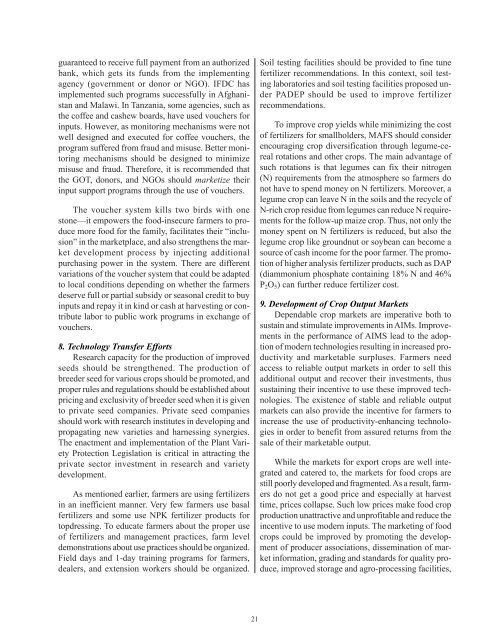An Action Plan for Developing Agricultural Input Markets in Tanzania
An Action Plan for Developing Agricultural Input Markets in Tanzania
An Action Plan for Developing Agricultural Input Markets in Tanzania
You also want an ePaper? Increase the reach of your titles
YUMPU automatically turns print PDFs into web optimized ePapers that Google loves.
guaranteed to receive full payment from an authorized<br />
bank, which gets its funds from the implement<strong>in</strong>g<br />
agency (government or donor or NGO). IFDC has<br />
implemented such programs successfully <strong>in</strong> Afghanistan<br />
and Malawi. In <strong>Tanzania</strong>, some agencies, such as<br />
the coffee and cashew boards, have used vouchers <strong>for</strong><br />
<strong>in</strong>puts. However, as monitor<strong>in</strong>g mechanisms were not<br />
well designed and executed <strong>for</strong> coffee vouchers, the<br />
program suffered from fraud and misuse. Better monitor<strong>in</strong>g<br />
mechanisms should be designed to m<strong>in</strong>imize<br />
misuse and fraud. There<strong>for</strong>e, it is recommended that<br />
the GOT, donors, and NGOs should marketize their<br />
<strong>in</strong>put support programs through the use of vouchers.<br />
The voucher system kills two birds with one<br />
stone—it empowers the food-<strong>in</strong>secure farmers to produce<br />
more food <strong>for</strong> the family, facilitates their “<strong>in</strong>clusion”<br />
<strong>in</strong> the marketplace, and also strengthens the market<br />
development process by <strong>in</strong>ject<strong>in</strong>g additional<br />
purchas<strong>in</strong>g power <strong>in</strong> the system. There are different<br />
variations of the voucher system that could be adapted<br />
to local conditions depend<strong>in</strong>g on whether the farmers<br />
deserve full or partial subsidy or seasonal credit to buy<br />
<strong>in</strong>puts and repay it <strong>in</strong> k<strong>in</strong>d or cash at harvest<strong>in</strong>g or contribute<br />
labor to public work programs <strong>in</strong> exchange of<br />
vouchers.<br />
8. Technology Transfer Ef<strong>for</strong>ts<br />
Research capacity <strong>for</strong> the production of improved<br />
seeds should be strengthened. The production of<br />
breeder seed <strong>for</strong> various crops should be promoted, and<br />
proper rules and regulations should be established about<br />
pric<strong>in</strong>g and exclusivity of breeder seed when it is given<br />
to private seed companies. Private seed companies<br />
should work with research <strong>in</strong>stitutes <strong>in</strong> develop<strong>in</strong>g and<br />
propagat<strong>in</strong>g new varieties and harness<strong>in</strong>g synergies.<br />
The enactment and implementation of the <strong>Plan</strong>t Variety<br />
Protection Legislation is critical <strong>in</strong> attract<strong>in</strong>g the<br />
private sector <strong>in</strong>vestment <strong>in</strong> research and variety<br />
development.<br />
As mentioned earlier, farmers are us<strong>in</strong>g fertilizers<br />
<strong>in</strong> an <strong>in</strong>efficient manner. Very few farmers use basal<br />
fertilizers and some use NPK fertilizer products <strong>for</strong><br />
topdress<strong>in</strong>g. To educate farmers about the proper use<br />
of fertilizers and management practices, farm level<br />
demonstrations about use practices should be organized.<br />
Field days and 1-day tra<strong>in</strong><strong>in</strong>g programs <strong>for</strong> farmers,<br />
dealers, and extension workers should be organized.<br />
21<br />
Soil test<strong>in</strong>g facilities should be provided to f<strong>in</strong>e tune<br />
fertilizer recommendations. In this context, soil test<strong>in</strong>g<br />
laboratories and soil test<strong>in</strong>g facilities proposed under<br />
PADEP should be used to improve fertilizer<br />
recommendations.<br />
To improve crop yields while m<strong>in</strong>imiz<strong>in</strong>g the cost<br />
of fertilizers <strong>for</strong> smallholders, MAFS should consider<br />
encourag<strong>in</strong>g crop diversification through legume-cereal<br />
rotations and other crops. The ma<strong>in</strong> advantage of<br />
such rotations is that legumes can fix their nitrogen<br />
(N) requirements from the atmosphere so farmers do<br />
not have to spend money on N fertilizers. Moreover, a<br />
legume crop can leave N <strong>in</strong> the soils and the recycle of<br />
N-rich crop residue from legumes can reduce N requirements<br />
<strong>for</strong> the follow-up maize crop. Thus, not only the<br />
money spent on N fertilizers is reduced, but also the<br />
legume crop like groundnut or soybean can become a<br />
source of cash <strong>in</strong>come <strong>for</strong> the poor farmer. The promotion<br />
of higher analysis fertilizer products, such as DAP<br />
(diammonium phosphate conta<strong>in</strong><strong>in</strong>g 18% N and 46%<br />
P2O5) can further reduce fertilizer cost.<br />
9. Development of Crop Output <strong>Markets</strong><br />
Dependable crop markets are imperative both to<br />
susta<strong>in</strong> and stimulate improvements <strong>in</strong> AIMs. Improvements<br />
<strong>in</strong> the per<strong>for</strong>mance of AIMS lead to the adoption<br />
of modern technologies result<strong>in</strong>g <strong>in</strong> <strong>in</strong>creased productivity<br />
and marketable surpluses. Farmers need<br />
access to reliable output markets <strong>in</strong> order to sell this<br />
additional output and recover their <strong>in</strong>vestments, thus<br />
susta<strong>in</strong><strong>in</strong>g their <strong>in</strong>centive to use these improved technologies.<br />
The existence of stable and reliable output<br />
markets can also provide the <strong>in</strong>centive <strong>for</strong> farmers to<br />
<strong>in</strong>crease the use of productivity-enhanc<strong>in</strong>g technologies<br />
<strong>in</strong> order to benefit from assured returns from the<br />
sale of their marketable output.<br />
While the markets <strong>for</strong> export crops are well <strong>in</strong>tegrated<br />
and catered to, the markets <strong>for</strong> food crops are<br />
still poorly developed and fragmented. As a result, farmers<br />
do not get a good price and especially at harvest<br />
time, prices collapse. Such low prices make food crop<br />
production unattractive and unprofitable and reduce the<br />
<strong>in</strong>centive to use modern <strong>in</strong>puts. The market<strong>in</strong>g of food<br />
crops could be improved by promot<strong>in</strong>g the development<br />
of producer associations, dissem<strong>in</strong>ation of market<br />
<strong>in</strong><strong>for</strong>mation, grad<strong>in</strong>g and standards <strong>for</strong> quality produce,<br />
improved storage and agro-process<strong>in</strong>g facilities,

















